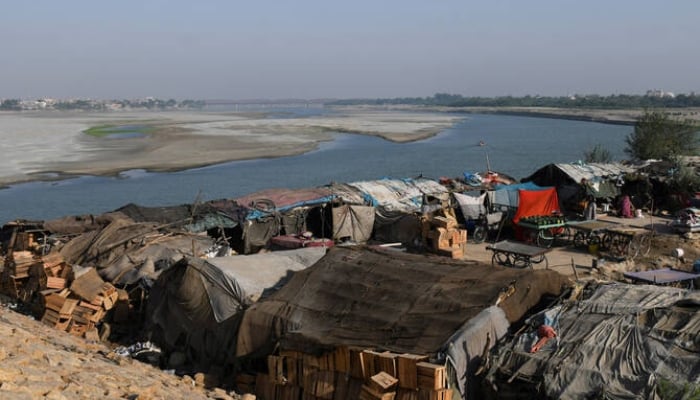Our Terms & Conditions | Our Privacy Policy
Over 44% Pakistanis now below poverty line under new WB threshold
A view of tent houses, belonging to squatters, on the dry riverbed of the Indus River in Hyderabad, on April 25, 2025. — Reuters
- Over 107m Pakistnis are living below poverty line.
- Over 39m included in extreme poverty category.
- New figures reflect updated international thresholds.
ISLAMABAD: A sizeable 44.7% of Pakistan’s population is now considered to be living below the World Bank’s newly updated international poverty line, set at $4.20 per person per day.
This figure comes as the World Bank carries out a routine global revision of its poverty thresholds to account for evolving price levels and fresh data.
As a lower-middle-income country, Pakistan’s new poverty statistics also reveal that the extreme poverty line, now at $3 per person per day, impacts 16.5% of the population, a substantial increase from 4.9% under the previous $2.15 benchmark. Furthermore, the upper-middle-income poverty line, established at $8.30 per person per day, encompasses a vast 88.4% of the country’s population.
As per the new poverty threshold, Pakistan’s more than 107.95 million people are living below the poverty line for earning less than Rs1,200 a day. Whereas, more than 39.8 million people in the country are included in the extreme poverty category, sources said.
These updated international poverty lines are derived from 2021 purchasing power parity (PPP) data provided by the International Comparison Program (ICP). The World Bank clarifies that this ensures poverty estimates remain accurate and comparable across nations, with the methodology consistent with updates initiated in 1990.
“The revisions help position Pakistan’s poverty levels in a global context and underscore the importance of continued efforts to reduce vulnerability and improve resilience,” said World Bank Country Director for Pakistan Najy Benhassine. “The new figures reflect updated international thresholds and improved data from other countries, not a deterioration in living standards.”
While these international lines are crucial for global progress tracking and cross-country comparisons, the national poverty line for Pakistan remains unchanged. It continues to serve as the primary domestic benchmark for policy and program targeting within the country. The underlying Household Income and Expenditure Survey (HIES) 2018/19 data, which informs both national and international estimates, also remains consistent.
The updated figures are part of the World Bank’s Global Poverty June Update 2025, an initiative aimed at enhancing the precision and relevance of global poverty assessments. A forthcoming World Bank Poverty, Equity, and Resilience Assessment for Pakistan is expected to offer more detailed context for these updated estimates, providing a comprehensive analysis of poverty, inequality, and non-monetary outcomes, alongside key drivers of poverty and a forward-looking agenda for fostering prosperity and resilience for all Pakistanis.
Images are for reference only.Images and contents gathered automatic from google or 3rd party sources.All rights on the images and contents are with their legal original owners.



Comments are closed.